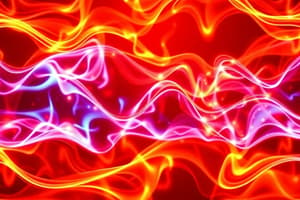Podcast
Questions and Answers
What will happen to the internal energy of the air in the cabin when the electric heater is turned on?
What will happen to the internal energy of the air in the cabin when the electric heater is turned on?
- Internal energy will remain constant.
- Internal energy will decrease due to heat loss.
- Internal energy will fluctuate erratically.
- Internal energy will increase as it absorbs heat. (correct)
When the system reaches thermal equilibrium after heating, the energy absorbed by the air is equal to which of the following?
When the system reaches thermal equilibrium after heating, the energy absorbed by the air is equal to which of the following?
- The heat gained from the heater. (correct)
- The heat lost by the electric heater.
- The heat lost by the walls of the cabin.
- The work done by the heater.
In a perfectly insulated system containing an ideal gas, increases in temperature are a result of what?
In a perfectly insulated system containing an ideal gas, increases in temperature are a result of what?
- Work done on the system. (correct)
- Decrease in gas volume.
- Heat transfer with surroundings.
- Expansion against an external force.
What characteristic of the air in the cabin affects how quickly it can reach the comfort level of 21°C after the heater is turned on?
What characteristic of the air in the cabin affects how quickly it can reach the comfort level of 21°C after the heater is turned on?
How is the energy balance represented for an ideal gas that is gaining heat in a system at thermal equilibrium?
How is the energy balance represented for an ideal gas that is gaining heat in a system at thermal equilibrium?
What does the first law of thermodynamics state about the quantity Q + W during a thermodynamic process?
What does the first law of thermodynamics state about the quantity Q + W during a thermodynamic process?
During a thermodynamic process, if a system transitions from an initial state ‘i’ to a final state ‘f’, what relies solely on these two states?
During a thermodynamic process, if a system transitions from an initial state ‘i’ to a final state ‘f’, what relies solely on these two states?
What is the relationship between work (W) and heat (Q) in the context of different paths in a thermodynamic process?
What is the relationship between work (W) and heat (Q) in the context of different paths in a thermodynamic process?
If an infinitesimal change occurs in a system's state, what can be said about the infinitesimal amounts of heat and work?
If an infinitesimal change occurs in a system's state, what can be said about the infinitesimal amounts of heat and work?
Which of the following statements accurately describes the property of thermal equilibrium in the context of the system’s phase transition?
Which of the following statements accurately describes the property of thermal equilibrium in the context of the system’s phase transition?
Flashcards are hidden until you start studying
Study Notes
Cabin Heating Scenario
- Room dimensions: 6m (length) x 4m (width) x 3m (height)
- Total volume of the cabin: 72 m³
- Contains one 2 kW electric heater
- Initial assumption of airtight conditions, with all heat from heater absorbed by air
- Target temperature for comfort: 21°C
Thermodynamics Principles
- The first law of thermodynamics states that energy loss by a hotter gas equals the energy gain by a cooler gas during heat exchange (Q1 = Q2).
- Heat added to a gas causes an increase in internal energy (ΔE_int) for ideal diatomic gases.
- Conservation of energy applies: ΔE_int = Q + W, where Q is heat absorbed and W is work done.
Internal Energy Changes
- For diatomic ideal gases, ΔE_int = (5/2)nRΔT, where:
- n is the number of moles
- R is the ideal gas constant
- ΔT is the change in temperature
- Heat capacity at constant volume (C_V) for diatomic gases: C_V = (5/2)R (approximately 20.8 J/mol·K).
Work and Heat Capacity
- Under constant volume conditions, all absorbed heat contributes to internal energy: Q = ΔE_int.
- For gas systems, heat and work contributions depend on the path taken during the thermodynamic process.
Heat Exchange Paths
- Along different paths connecting initial and final equilibrium states, Q and W values can vary, but the total change in internal energy remains constant.
- Mathematically expressed as: ΔE_int = Q + W.
Molar Heat Capacities
- Molar heat capacities differ for various gas types, influencing how they respond to temperature changes:
- Monatomic ideal gas: C_P = 20.8 J/mol·K, C_V = 12.5 J/mol·K, γ = 1.67
- Diatomic ideal gas: C_P = 29.1 J/mol·K, C_V = 20.8 J/mol·K, γ = 1.40
- Polyatomic ideal gas: C_P = 33.3 J/mol·K, C_V = 24.1 J/mol·K, γ = 1.33
Summary of Key Terms
- Internal Energy (ΔE_int): Energy related to the randomness of gas molecules.
- Molar Heat Capacity (C): Energy required to raise the temperature of one mole of a substance by one Kelvin.
- Heat (Q): Energy transfer due to temperature difference; work (W) is energy transfer associated with forces acting through distances.
Studying That Suits You
Use AI to generate personalized quizzes and flashcards to suit your learning preferences.




